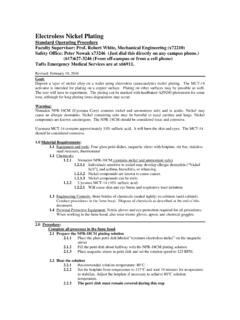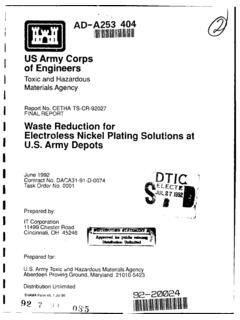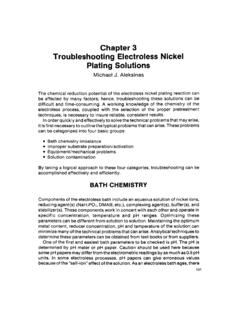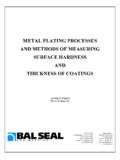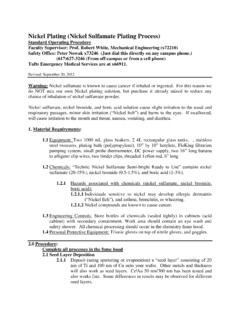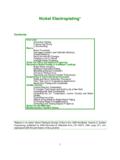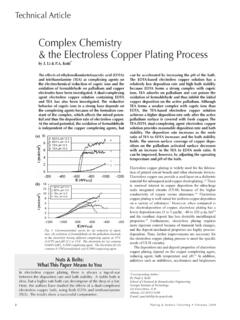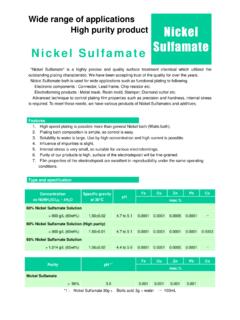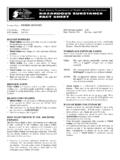Transcription of TF-131A FILTRATION OF NICKEL SOLUTIONS
1 FILTRATIONS olids can be removed from the NICKEL bath byrecirculating the solution through a filter. The filtershould employ filter media with an average particleretention of 15 micron down to sub-micron with, orwithout, filter aid. Coarser or slightly denser media maybe used, depending upon the dirt load and degree ofclarity required. With a higher flow rate, a coarserfilter media will attain the same degree of clarity as adenser media at a lower flow rate. The coarser car-tridge has higher dirt holding capacity and longer rates per hour will also vary from two to tentimes the volume of the tank. One tank turnover perhour is not sufficient in most cases to remove all thesolids in suspension before they settle to the in the plating tank requires periodiccleaning and downtime of the FILTER CARTRIDGE SELECTIONF ilter media of cotton or polypropylene fibers canbe used on most NICKEL baths.
2 Cotton would bepreferred on sulfamate SOLUTIONS , and polypropyleneon high chloride and fluoborate baths. Polypropylenefibers on a polypropylene core are the most universalcartridge materials because of their suitability for allnickel SOLUTIONS and also for their resistance to acidused to dissolve accumulated iron precipitate from themedia. This can be done by flushing with hydrochlo-ric acid (can be spent acid from other operations) orby acid soaking the cartridges off-line while using analternate set of cartridges in the filter chamber. In thisway, one set is always ready for reuse in the filter. Besure to flush any new synthetic fiber cartridges byrunning warm water through the filter just prior tousing, to remove the slight organic residue which isleft from the winding OFNICKEL SOLUTIONSLOW COST OPERATIONB ecause of the principle of depth construction,each string wound 2 " diameter x 10" long filtercartridge can hold as much dirt as would collect on3 sq.
3 Ft. of surface media of the same density. Whensized on the basis of two cartridges for each 100gallons of solution, the filter will usually operate for sixto eight 40 hour work weeks before filter cartridgereplacement is necessary. Very little labor is requiredto replace the filter cartridges and the solution lossshould be at a minimum. On a 1,000 gallon tank basedon the use of 24 cartridges at $ each plus $ labor, divided by 6 weeks of "unattended" opera-tion, the FILTRATION cost would amount to only about $ week. This will go up or down, depending upon thedirt load and the porosity of the filter cartridge exceptionally heavy dirt loads are antici-pated, such as on replating of auto bumpers wherecleaning is usually incomplete or in plating of tubularitems, three filter cartridges should be used per filters may be operated with filter aid inthe same manner as other surface type filters - whereeach cartridge is equal to sq.
4 Ft. of area. In place ofthe cartridges, sleeves made of polypropylene maybe used. Slurry tanks to assist in coating the filtercartridges with filter aid are available on some filters using two cartridges for every 100gallons of solution will usually run for about one weekbefore servicing is required. The operator can extendthis "unattended" time by adding additional filter aidat periodic intervals through the slurry tank to helpmaintain a fresh porous surface on the filter large systems having slurry tanks with agitation, NICKEL deposits, due to their lustrous finish, are often plated for decorative purposes in tanks suitablefor rack or barrel operation. Agitation is usually recommended and organic compounds are added toget the best leveling and brightness. Other NICKEL SOLUTIONS are used for engineering and salvage applicationsor electroforming, which demand a near perfect plate.
5 These contain anti-pitting agents instead of organicbrighteners. Bright and semi-bright NICKEL electrolytes require the continuous or periodic removal oforganic breakdown products from brighteners by use of activated carbon. Carbon purification may bedesirable for fresh Watts and sulfamate NICKEL SOLUTIONS prior to the addition of wetting agents. Initialand continuous carbon treatment with at least two tank turnovers per hour are suggested. (Hull celltests will reveal the need for batch carbon treatment or change of carbon.) The NICKEL -iron plating bathsmust be filtered and purified like any other bright NICKEL purification by "dummy" plating to remove undesirable metallic impurities, such as copper,is frequently employed in conjunction with FILTRATION equipment by either pumping from a separate tankor weir filled with overflow solution, or by recirculating through the slurry tank for this slurry feed pump may be used so that somesolution with filter aid is continuously added to thefilter media surface (body feed).
6 As a result, an equalmixture of solids and filter aid is maintained to keepthe cake, which is forming, as porous as possible. Theslurry feed pump may enable the filter to run for large rubber-lined systems, which havemaximum distance between the cartridges, have beenknown to run for three to six months. Here again,periodic flushing with spent acid to remove precipitatediron hydroxide is possible. Often, the filter media canbe rejuvenated to a like-new condition after the ironprecipitate is dissolved. Large systems can be set upwith valving for backwashing which can minimize theneed for opening the filter. Some filters are precoatedand backwashed weekly, others METHODSWhen powdered carbon is used in the filter, 15 mi-cron or denser filter cartridges should be used. Filtersleeves may also be used and they are desirablebecause they can be washed and reused.
7 Bothcartridges and sleeves must first be precoated withfilter aid to prevent migration of carbon fines fromeither powdered or granular carbon, and also to makeit possible to clean the cartridges for reuse either bymanual rinsing or periodic or continuous carbon treatment on abypass, plastic canisters containing from 1 to 14 poundsof granular carbon are efficient and easy to refill. Largerbulk carbon chambers holding 50 to 100 lbs. ofTF-131 Acarbon are also available with and without contain a built-in trap filter cartridge with3 micron retention for carbon fines. The precoatedcartridge also becomes its own built-in trap filterpreventing migration of filter aid and carbon into thesolution. Since the cartridge is sufficiently dense toresist pressure differentials of 50-60 psi, breakthroughsare FILTRATION SYSTEMSF iltration systems are offered in both in-tank andout-of-tank pump and filter arrangements.
8 Usually, SOLUTIONS such as NICKEL sulfamate, tin- NICKEL orWatts NICKEL , which do not require continuous carbonpurification, may use an in-tank pump and filtersystem. The standard bright NICKEL SOLUTIONS , highchloride or other, with or without agitation, use larger,out-of-tank systems which have slurry tanks availablefor the convenient use of filter aid and carbon. It isalways desirable, especially on larger systems, to adda slurry tank. Even though constant carbon purifica-tion may not be intended, it can be used for periodicbatch carbon treatment or the addition of chemicalsthrough the filter to the plating tank. Filter systems canalso be set up so that the constant or intermittentdummying of the solution can be done in the slurry tank if an overflow line is provided in the tank for thispurpose. To make the FILTRATION system the mostfunctional and yet easy to operate, bypass piping,valves, slurry tank, dummy arrangement, precoat,and body feed accessories can be OF NICKEL SOLUTIONS (cont'd) FILTRATION systems from small laboratory sizedunits to full production models



